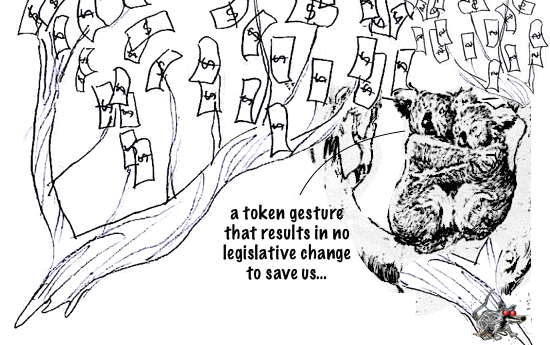Search
Recent comments
- waste of euros....
2 days 1 hour ago - macron l'idiot....
2 days 2 hours ago - pomp and charity....
2 days 3 hours ago - overshoot days....
2 days 3 hours ago - "americamaidan"
2 days 3 hours ago - australia sux....
2 days 3 hours ago - the little children....
2 days 3 hours ago - delayed food....
2 days 11 hours ago - free expression....
2 days 12 hours ago - macrolympicus....
2 days 13 hours ago
Democracy Links
Member's Off-site Blogs
legal protection of habitat. koalas eat leaves, not money...
 koalas
koalas
The Australian Koala Foundation has called for a koala protection act and legislative action to curb land clearing.
It warns koalas are also in danger in Victoria and South Australia.
“This change in status, unfortunately, is nothing but a token gesture that results in no legislative change to save the koala,” foundation chair Deborah Tabart said.
“Behind all the photo opportunities and political rhetoric they (the federal government) continue to approve the destruction of koala habitat.”
Ms Ley pointed to chlamydia vaccines for koalas, the use of drones to surveil populations and habitat restoration as ways governments were working to protect the marsupial.
“There are international issues when it comes to climate change. Of course, Australia is playing its part. But there’s much that we can do in our communities,” she said.
Since 2001, koala populations in NSW have declined by between 33 and 61 per cent. A state parliamentary inquiry in 2020 warned the marsupial would likely become extinct before the middle of the century without urgent intervention.
At least 6400 koalas were wiped out by the 2019-20 summer bushfires alone.
Similarly, Queensland koala populations have at least halved since 2001 because of drought, fires and deforestation.
The federal government argues the endangered listing will highlight and help address threats to koala populations.
It wants Queensland, NSW and Victoria to sign up to a national recovery plan worth $50 million over four years.
WWF-Australia conservation scientist Stuart Blanch urged federal and state governments to commit to doubling koala numbers on the east coast by 2050.
“Koalas have gone from no-listing to vulnerable to endangered within a decade. That is a shockingly fast decline,” he said.
“Today’s decision is welcome, but it won’t stop koalas from sliding towards extinction unless it’s accompanied by stronger laws and landholder incentives to protect their forest homes.”
Mr Blanch said the listing was “grim but important”.
“It helps people who want to save koalas to do the right thing,” he said.
“That’s ministers who make decisions on development, it’s Treasury officials who work out whether to put money into funding farms to support koalas or buying up native logging wood supply agreements in koala country.”
An Australian Conservation Foundation analysis found the amount of koala habitat approved for clearing had increased every year since 2012, when east coast koalas were first listed as vulnerable.
It said the federal government had rubber-stamped the loss of more than 25,000 hectares of habitat, equivalent to 526,000 average-sized blocks of residential land or about 10,400 Sydney Cricket Grounds.
Approvals were granted for 63 mostly mining projects in Queensland, NSW and the ACT.
The federal government has listed the marsupial as endangered as it continues to fight attempts to downgrade the Great Barrier Reef’s UNESCO listing to “in danger”.
It argues the two can’t be compared and the reef shouldn’t be singled out because climate change is threatening all World Heritage sites.
Read more:
https://thenewdaily.com.au/news/2022/02/11/koalas-nsw-qld-act-endangered/
See also: https://yourdemocracy.net/drupal/node/35140
FREE JULIAN ASSANGE NOW !!!!!!!!!!!!
- By Gus Leonisky at 13 Feb 2022 - 5:04am
- Gus Leonisky's blog
- Login or register to post comments
rewilding Lungtalanana...
Others can speak to the ecological significance of restoring Lungtalanana’s unspoiled glory. Kulai Sculthorpe just knows it’s where he belongs and what he needs to do.
“This is where my ancestors are from,” he says. “I’m back here on the same Country as they walked thousands of years ago.”
Drawing upon Indigenous knowledge passed down over generations, conservationists have embarked on an ambitious pilot project to rewild the 8230-hectare island off Tasmania’s northeast coast.
The genetically unique Bass Strait Island wombat will most likely be the first of at least six native species returned to the ruggedly beautiful member of the Furneaux Group.
European land clearing, bushfires and infestations of feral cats, rodents and rabbits gradually obliterated its once plentiful presence on Lungtalanana, along with that of the Bennett’s wallaby and the short-beaked echidna.
What makes the scheme unique, however, is that it will also involve cultural burning, a practice managed by Aboriginal people on the island for more than 40,000 years, in a bid to rebalance the animals’ damaged habitat.
Indigenous know-howFor Sculthorpe, one of five young Pakana rangers selected to take part in the initiative, his participation is everything. Although, he’s not inclined to say so in so many words.
“It’s more of a feeling,” he offers when asked why the project is important. “It’s where I’m supposed to be in my opinion … this is where my people are from.
“It means so much to be here and to, you know, do the same practices and carry them out, that they were doing.”
Aboriginal people are thought to have lived on the island until about 4500 years ago, when rising seas forced them to retreat to the Tasmanian mainland.
Along with neighbouring Flinders, Cape Barren and about a hundred smaller islands, Lungtalanana is in fact a mountain remnant of the ancient land bridge which once connected what is now the island state and Victoria.
The rewilding project is being led by the Tasmanian Aboriginal Centre (TAC) and World Wide Fund for Nature-Australia in collaboration with The University of Tasmania.
Read more:
https://thenewdaily.com.au/life/science/environment/2022/02/12/bass-street-indigenous-burning/
Read from top.
FREE JULIAN ASSANGE NOW !!!!!!!!!!!!!!!!!